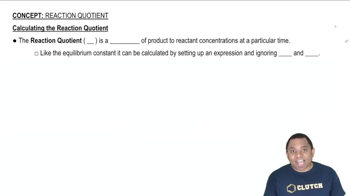Here are the essential concepts you must grasp in order to answer the question correctly.
Le Châtelier's Principle
Le Châtelier's Principle states that if a dynamic equilibrium is disturbed by changing the conditions, the system will adjust to counteract the change and restore a new equilibrium. This can involve changes in concentration, pressure, or temperature. In the context of the given equilibrium, removing Cl<sup>-</sup> ions will shift the equilibrium to the left, favoring the formation of more reactants to compensate for the loss.
Recommended video:
Equilibrium Constant (K)
The equilibrium constant (K) is a numerical value that expresses the ratio of the concentrations of products to reactants at equilibrium for a given reaction at a specific temperature. For the reaction Ag<sup>+</sup>(aq) + Cl<sup>-</sup>(aq) ⇌ AgCl(s), K is defined in terms of the concentrations of Ag<sup>+</sup> and Cl<sup>-</sup>. Changes in concentration of reactants or products will affect the position of equilibrium but not the value of K itself.
Recommended video:
Reaction Quotient (Q<sub>c</sub>)
The reaction quotient (Q<sub>c</sub>) is calculated using the same formula as the equilibrium constant but with the current concentrations of the reactants and products, regardless of whether the system is at equilibrium. By comparing Q<sub>c</sub> to K, one can determine the direction in which the reaction will shift to reach equilibrium. If Q<sub>c</sub> is less than K, the reaction will shift to the right, while if Q<sub>c</sub> is greater than K, it will shift to the left.
Recommended video:

 Verified step by step guidance
Verified step by step guidance


